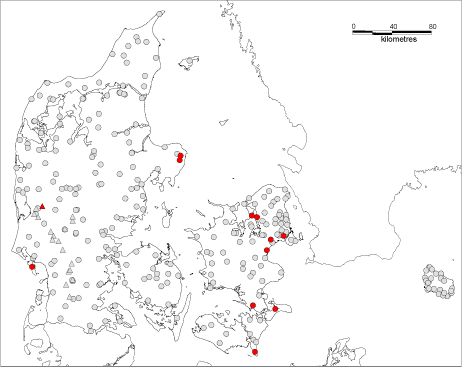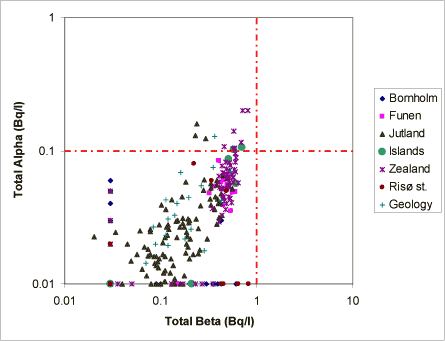|
| Front page | | Contents | | Previous | | Next |
Radioactive isotopes in Danish drinking water
7 Results
The locations of water works and water supplies from which samples of drinking water were collected are shown in Fig. 1. Sampling in 2001 covered Bornholm and those water works in the country with
the highest production of drinking water. In 2002 sampling focused on Jutland including locations suggested by GEUS as potential sites for elevated levels of natural radionuclides in groundwater due to
geological conditions. In 2003 sampling focused on Zealand, Funen and the southern part of Jutland including those water works and single supplies where the concentrations exceeded the screening levels.
The locations in Fig. 1 are marked in dark colour if the concentrations of radioactivity were at the screening levels or higher. Most of the results were at or below the screening levels.

Fig. 1. Locations for sampling of drinking water marked with circles. The groundwater locations selected on geological grounds are marked with triangles. Dark coloured marks indicate that the screening levels were exceeded.
The analytical results are presented graphically in a scatterplot, Fig. 2, which shows total alpha versus total beta radioactivity concentrations in the samples analysed. The dashed lines indicate the screening
levels.

Fig. 2. Scatterplot of observed total alpha and beta radioactivity levels in drinking water in different part of the country. Untreated groundwater from borings selected for geological reasons are included marked with + . The screening levels are indicated by dashed lines.
Radon concentrations above the detection limit were found on Bornholm only, in agreement with a previous investigation of radon from Danish water works (National Board of Health, 1986). Radon
concentrations in drinking water on Bornholm are higher in un-oxidized water at most sites compared to oxidized water.
The highest radon concentrations of 87 Bq/l are found at Vang. However, oxidized waters at the same water works only show radon concentrations of 43 and 48 Bq/l. The relatively high radon
concentration in drinking water at Vang is not reflected in correspondingly high alpha and beta values.
Recommendations from the Nordic countries and from the European Commission suggest an exemption level for radon in drinking water of 100 Bq/l (Nordic Radiation Protection Authorities, 2000;
Kommissionens henstilling, 2001). The radon values measured in samples of both oxidized and non-oxidized drinking water in this study are well below this level.
The detailed numerical results are given in the Appendix. The results of total alpha and beta radioactivity are given in Tables 1-5 for Zealand, the islands south of Zealand (Lolland, Falster and Møn), Jutland,
Funen and Langeland, and Bornholm. Table 6 lists water works and supplies with levels of total alpha and beta radioactivity at the screening levels or higher. Tables 7 and 8 give results of total alpha and
beta radioactivity including uranium and radium isotopes for locations with concentrations at the screening levels or higher. Table 9 gives results for the Risø monitoring stations of total alpha and beta
radioactivity including uranium and radium isotopes. Table 10 gives the results of radioactivity in drinking water from untreated groundwater supplies in Jutland selected for geological reasons
The concentrations of total alpha and beta radioactivity in drinking water were generally found to be below the screening levels. Out of a total of 294 water supplies investigated, samples from 9 supplies
(corresponding to 3%) have shown concentrations at the screening levels or higher. In all cases this was due to increased alpha radioactivity.
Concentrations of total alpha and beta radioactivity in drinking water above the screening levels were found near the following locations: Skjern, Ebeltoft, Grenå, Solrød, Stege, Vordingborg, Ishøj, Gedser,
Jægerspris, Frederikssund, Hvidovre and Fanø. The highest levels of total alpha radioactivity in drinking water were found at Grenå and Ebeltoft in Jutland with levels up to 0.13 Bq/l and in Frederikssund on
Zealand with levels up to 0.2 Bq/l. The water works in these areas were subject to a closer investigation with repeated sampling from individual bore holes and determination of total alpha and beta
radioactivity including uranium and radium in these samples. The results demonstrate that the increased alpha radioactivity is due mainly to uranium in the drinking water. The variation of uranium
concentrations is large between different boreholes from the same area. At Grenå the concentrations of 234U and 238U were found in the range 0.021-0.14 Bq/l (2-10 µg/l), in Ebeltoft in the range
0.008-0.027 Bq/l (0.8-2 µg/l), and in Frederikssund the uranium concentrations were found in the range 0.00002-0.22 Bq/l (2 ng/l – 15 µg/l).
Borings in the Frederikssund area showed generally the highest concentrations of 226Ra, ranging from 0.005 to 0.018 Bq/l. Other water works with somewhat elevated 226Ra concentrations were in Stege,
Vordingborg, Gedser and Skjern with 0.011, 0.015, 0.014 and 0.035 Bq/l respectively. The remaining water works analysed showed 226Ra concentrations generally below 0.005 Bq/l.
The elevated total alpha levels are generally explained by elevated uranium concentrations. Some exceptions were however found at Stege and Vordingborg with exceptionally low uranium concentrations.
The elevated total alpha levels may in this case instead, at least partly, be explained by the elevated 226Ra.
In some cases elevated total alpha concentrations may neither be explained by elevated uranium nor by 226Ra concentrations. In these cases the contribution from other alpha emitters such as 210Po and/or
228Th with daughter products could play an important role (Parsa, 1998; Parsa et al., 1999).
| Front page | | Contents | | Previous | | Next | | Top |
Version 1.0 April 2006, © Danish Environmental Protection Agency
|